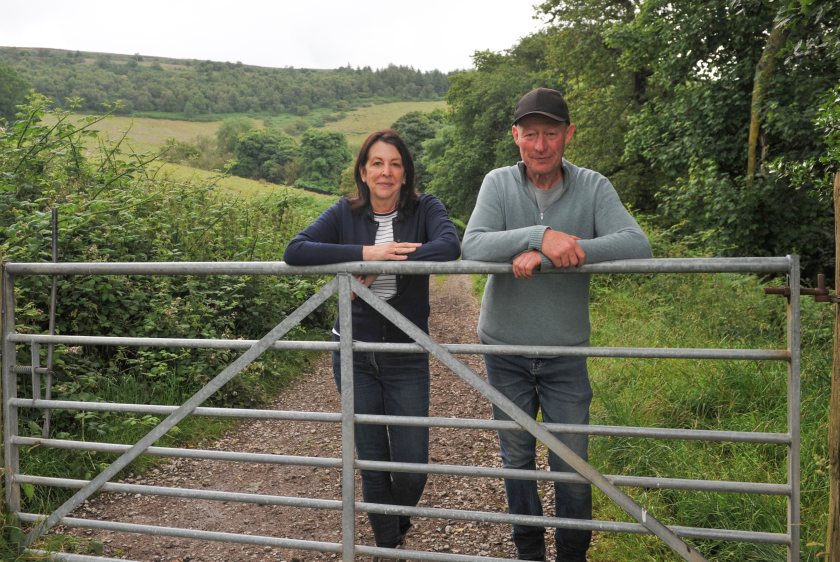
A farm-based tree management and planting scheme in Wales is demonstrating how landlords and tenants with aspirations can work together for mutual gain.
Tudor and Julia Hughes farm sheep on two holdings at Llangwyfan, near Denbigh, buying in 1,200 ewe lambs annually to rear and sell as yearlings, and also growing 75 acres of maize for a local dairy farmer.
The land base includes 127ha (316 acres) at Llangwyfan Farm which Tudor’s father, H. Clwyd Hughes, initially took on as a tenant in 1957 and later purchased in the early 90s.
Tudor and Julia, who both attended the Welsh Agricultural College at Aberystwyth, also rent land from a neighbour, farming nearly 500 acres across both farms.
With one eye on realising the income potential of the farm and enhancing its value for the environment, nature and wildlife, in 2022 they participated in a Farming Connect diversification webinar which explored woodland management and planting.
“It encouraged us to look at the assets we had and to consider how we could generate an income from those," Julia explains.
Their farm resource includes just under 12ha of woodland, but they hadn’t previously truly considered it as an asset.
The knowledge they gained from experts at the webinar and at subsequent events and talks helped them to also understand the value of managing existing woodland.
“We saw the benefits of bringing that back as an active asset, integrating it into the business side of things by producing timber, but also adding to those existing resources by creating additional woodland," says Julia.
They took that mindset with them to the Farming Connect Innovation and Diversification event at Builth Wells in June 2022, where they got further advice from tree experts.
“The reality was that if we were going to progress with managing the trees and planting more, we were going to need some hand holding because we didn’t have the skills and the expertise in that area," Julia says.
The Hughes’ were not only interested in managing the two woodlands on their own farm but the two on their rented land too.
The landlord, who shares their environmental aspirations, was extremely supportive.
The Hughes’ applied for a Natural Resources Wales (NRW) Forest/Woodland Management Plan, that was 80% funded through the Farming Connect Advisory Service.
This gave them access to woodland specialists Simon Hunt and Mike Richards, both formerly of Coed Cymru, who assessed the woodland.
Implementing the management plan will involve removing certain trees to enable ancient woodland features to be preserved.
“Every tree has been considered in terms of its value for conservation and biodiversity when selecting trees to be felled," says Julia.
After the Woodland Management Plan was approved, Simon applied to NRW for a felling licence for permission to fell the trees, which was approved.
Mike is now marking the selected trees to be felled within the stands of available marketable timber and will subsequently help the Hughes’ find suitable woodland contractors to undertake the work of felling and extracting the timber.
He will also support them with advice on producing contracts of works for the contractors to adhere to.
A key priority is for dominant trees to be removed so that species balance is restored. “Sycamores in particular are dominant – there are far too many for the oak trees to survive long term," says Julia.
“This will allow increased light levels to penetrate the woodland canopy and reach the woodland floor to encourage ground flora growth and the natural regeneration of trees,” says Julia.
Another felling target will be ash with many of these now succumbed to disease and requiring removal.
But not all timber will be removed during harvesting as residues will be left for enhanced habitat as standing or fallen deadwood which can often be missing from overmanaged woodland.
The greater the volume of deadwood in a woodland the higher its biodiversity value - the amount of deadwood in forests and woodlands is now used as a key international indicator of the biodiversity of forest ecosystems.
The Hughes’ were also keen to look at the potential for planting new areas on their least productive land and on field margins, areas that would not impact on their key farming operations. Their landlord supported that too.
They applied for a Woodland Creation Planning Scheme through Rural Payments Wales and again they are working with Mike, who is also a registered woodland planner, on this.
“He helped us identify areas for planting and then consulted with NRW on these to avoid impeding on existing habitat condition," says Julia.
As the canopy expands in the newly planted woodland, the bracken will deteriorate and allow a new layer of woodland vegetation to develop.
All of the rented land and part of Llangwyfan Farm is designated as an Area of Outstanding Natural Beauty (AONB), a classification now renamed as National Landscapes.
The transition from the planned new woodland area, ffridd, onto the open moorland above will benefit key species such as skylark, meadow pipit and wheatear and has potential to be advantageous to black grouse too.
“We have also been consulting and collaborating with Denbighshire National Landscapes on this," says Julia.
The Hughes’ and their landlord have a good track record of working together, previously developing a grazing management plan to enhance the skylark nesting season and seeding wildflowers growing on the hill.
